Every day we communicate face to face with others on topics like shopping, traveling, school, work, or other things going on in our lives. We like to let those we have a connection with to know what is important to us at the time being but sometimes we can’t get the words out to express how we are feeling. Sometimes when we interact with others, we do not say a word but choose to express ourselves in nonverbal ways and leave the interpreting up to who is around us. Nonverbal cues can be easier to show others what we are thinking, feeling, or even expressing through our face and body to get our points across without saying a word. We also tend to use both verbal and nonverbal cues at the same time when we are speaking to others. For example, we tend to do things like talk with our hands or move our eyes from side to side to gather our thoughts, like we’re thinking based on the expressions on our face. Do you do these things? Why? Each gender has their own way of interpreting and using these nonverbal cues to communicate with people in their social group. Have you ever heard of women’s intuition? Women’s code? This is based on how women tend to see and think like other women do and therefore most women know what a certain single sigh means but then a guy may not have a clue as to what that same sigh means. These nonverbal cues are seen more by women than men because women tend to use these cues more often. Learning how to interpret these nonverbal cues given by each gender is important to show meaning, how often, and why we use these signs. Wouldn’t you want to be able to interpret what these signs mean? Let’s explore the nonverbal cues we give off in our facial expressions and body language and how they are the same or different between genders.
First, let’s take a look at interpreting facial expressions through some experiments done focused on emotion recognition. We have many emotions like happiness, disgust, anger, fear, sadness, and surprise that can be recognized from different parts of the face. For instance, the mouth region holds happiness and disgust, the eye region holds anger and fear, and from both regions holds sadness and surprise. Did you know each of your emotions comes from a different region of your face? In real life, it was shown that it is more accurate to read these emotions from looking at the front view of our faces instead of from the side profile. However, we could also be standing from a side profile when talking to others and not just the front view. So, an experiment was done to show a situation in which both the side and front view were looked at and how precise the interpretation was from each view. The statistics document from the front view our facial expressions of anger, sadness, and fear are more recognized this way then these same emotions in the side profile. However, no huge difference in data was found for surprise, disgust, and happiness between both the front and side profiles. This proves that we have trouble recognizing certain emotions when looking at others facial expressions regardless of gender, whether from front or side profile, because we cannot see the pattern on our face as an emotion but as how your face looks right now. For example, have you noticed when someone talks that their facial expressions morph to fit the situation depending how quiet, loud, or emotionally they talk? Next time you talk to one of your friends try to observe how their facial expressions, the muscles in their face, change depending on the mood they are in, and if it looks the same from the front to the side profile. Both genders have a certain way of communicating through their faces to the same or opposite gender, but the result is the same, a facial expression described here will mean the same thing across both genders. 1

Next, let’s take a look at how our facial expressions and gender stereotypes influence our impressions. Additional studies showed when we first meet someone, we form an impression of them based on their facial appearance because we start to see traits in their face. For instance, “One explanation for why facial expressions are important in forming impressions is that expressions can serve as a behavioral cue from which people garner information”, like a smile. When you meet a person who is smiling, they give off a warm vibe and a positive impression is now made. In the study, people are asked to look at photos of the many facial expressions we have and rate them based on personality traits that we might possess. Over the multiple tests given it was shown that those who smile where associated with happy traits. This research also stated, “that women smile more than men…, a difference both men and women believe to be true”. To test this multiple yearbook photos were examined and “among those with smiles, women were twice as likely as men to display a broad smile; however, among non-smiling faces, men were almost eight times more frequent than women” proving that women smile more than men. Is this gender smiling related to gender stereotypes? Women are stereotyped as having more of a warmth which goes with a smiling behavior and men are stereotyped as being tough which doesn’t match smiling. Have you noticed which gender smiles more? Gender stereotypes are leading us to behave as women with a kind nurturing soul and men with a competent stoic soul and may play a role in our ‘smiling’ facial expression behavior. In this study, people were asked to look at men and women who took two pictures of themselves side by side, one smiling and other not, and rate their traits. Can a simple act of smiling really be related to interpreting our facial expressions? By going through this study, we learned that nonverbal cues affect impressions of others: “facial expressions are used differently as cues when evaluating men’s and women’s traits”. We now know about a gender stereotype, ‘smiling’ as a facial expression, and can explore more into what other expressions we have. 2

Next, let’s take a look at how the way we look at objects or people with parts of our face, like eyes or mouth, can help us see what emotion lies beneath. Humans are very good at translating facial expressions without knowing they did so, and this can be proved by looking at a photo and observing the face. While looking at these pictures we tend to be happy when a smile is on your face and mad when a smirk is on your face. Our brain is affected by looking at these pictures by sending signals to parts of our brain when we are observing these pictures. Our facial muscles start to tweak themselves to fit the certain expression needed and form a new view of what your face is now telling others. Did you know that eye tracking is a great way to tell what people are thinking? For example, ” several eye-tracking studies have shown that the processing of facial expressions depends on directing gaze toward two main diagnostic areas of interest (AOI): the eyes and the mouth”. Every emotion we give off has a different pattern forming with our eyes and mouth which can help in determining what we mean with our face. To further explain, with ” a focus on the mouth region for joyful faces and a focus on the eye region for negative emotions such as sad faces (Schurgin et al., 2014), angry faces (Eisenbarth & Alpers, 2011), or fearful faces (Bayless, Glover, Taylor, & Itier, 2011; Wells, Gillespie, & Rotshtein, 2016)”.
Have you noticed when you are fearful your eyes get bigger but when happy you flex a smile? Well think about if we add our eyes into these expressions, will we see what you are really feeling? In this article, the study depicts how our eyes change with each emotion as well leaving another way to interpret someone’s face in order to know what they are feeling. As an amateur photographer, I find this finding to be interesting because using these facial expressions of our eyes and mouth help with placement of the face when taking a portrait picture. The way in which we set up a person’s face for a picture can give lots of nonverbal cues that help in knowing what the person who was posing felt at that time. For instance, if you look at a magazine cover of a models face posing with a fierce expression, you might say, ‘wow that person is cool’ and want that shade of eyeshadow they are wearing. Positioning your face just right so you have your face turned to the side, raised up a little, with a hand grazing your cheek, and your lips plumped it would make you look at this picture with a certain perspective. In other words, it is very important how you position your eyes and mouth for a portrait shot so your audience can interpret the mood, facial expressions, body language, and environment around you. Every tweak to the face can show a different expression making every angle a unique perspective for the readers of these such magazines and to make us feel what they are promoting and get us interested in what they are selling. Both men and women can use these facial positions of the eyes, mouth, or other areas of themselves to set a certain mood, that should be seen as the same across both genders, however, people often misinterpret to form their own thoughts. Overall, how we interpret the eyes and mouth in each expression can help us depict what our peers truly want us to know without the use of words. 3
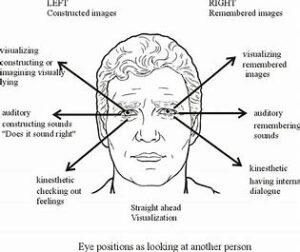
Next, let’s take a look at how different men and women communicate using head nods in a classroom setting of college students. Over time, we have come to conclude that each gender has their own “gender-specific patterns” and the way we communicate in different styles towards others is the most common one. There are “gender differences in such verbal aspects as talkativeness, language style, and content of speech (Tannen, 1990) and nonverbal aspects such as personal space, body posture, gaze, facial expression, and amount of touching”. The male style of communicating tends to be more dominant, aggressive, structured, and have very little intimacy, but the female style of communicating tends to be more emotional, cooperative, and has much intimacy. Have you heard of a backchannel response? It is something that women use more of than men in a conversation and is defined as “short vocal responses that display the attentiveness of the listener and include non interruptive comments such as “hmmm,” “uh-huh,” “yeah,” or “right”‘. Men use backchannel responses less frequently, tend to interrupt conversations more than women, make less eye contact than women, and speak to others more forcefully than women. Head nodding is a type of backchannel response that we often use, more by women than men, to show that we are agreeing with someone and how this is similar to if someone was to bow towards you. A gender difference in communication, generally speaking, is “dominant and powerful people use features of an aggressive male language style whereas subordinate and powerless people use features of a facilitative female language style” and can be tested through multiple experiments. One experiment examined the nonverbal domain of head nodding of female and male college students. The experiment took place inside the classroom setting with both male and female professors and students to show some effects of gender and status. The results proved that women tend to nod more than men and students tend to nod more than their professors and while observing, the students noticed that showing a smile is highly likely when you are observed. Do you nod your head when listening in the classroom setting? Is it instinct or did you adapt to doing this habit? Are you male or female? You should check out this article and research study in more depth to further understand why we tend to nod when listening in a classroom setting. 4
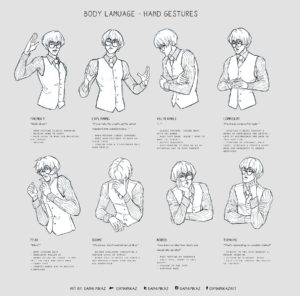
Observing body language can help us to interpret others body language better and correctly. The image at the end of this paragraph is a summary of how we do this. Firstly, making eye contact is a nonverbal way to communicate, one reason is to indicate your interest in who you are talking to. Researchers have also proven that we have a preferred amount of time we want to look at someone using eye contact while speaking to them, and it is three seconds long on average. The direction you look in, left or right, can determine if you are recalling a memory of an experience and emotion, looking left, or indicating to others that you are in the process of creative thinking, looking right, which can be another nonverbal cue of lying. Consistent eye contact, which people prefer, is a good indicator that you are interested in them talking, and breaking eye contact once it is established but then looking right back is a sign that you are in a flirting behavior. Secondly, puckered lips mean desire and can also represent a flirtatious gesture. Next, pursed lips could indicate a disapproval, dislike, or distrust of the person you are talking to. Next, parted lips could be a stronger flirting signal, especially if you are also licking your lips. Next, biting your lips can point to a sign of you being stressed or have anxiety but on the other side of things can also mean desire in certain settings. Thirdly, according to the hand portion of the poster, if you tend to finger tap while someone is talking then this indicating your disinterest and you’re signing that you are bored or impatient. Next, if your palms are facing up this indicates to someone that you are in a mood of acceptance and being open, as well as indicating to them how sincere and honest you are being. Next, on the opposite side of palms up is hidden hands which usually shows an indication of being less open and honest to those around you. Lastly, the face platter, placing your chin on top of your hands interlocking fingers, is showing a positive gesture and interest in the person in front of you. Did you know these nonverbal cues existed before reading this? Do you use any of these signs without knowing you did? Will you look out for these signs more now and observe how you appear towards others? This poster was just a scratch on the surface of what nonverbal cues are out there to observe, but we are more informed now then we were before and can use this information in our day-to-day lives.
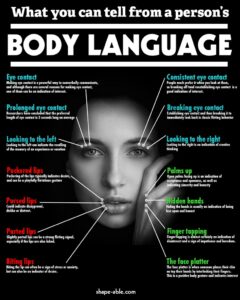
Finally, let’s take a look at how these facial expressions and body language can apply to my photography hobby, posing people in the right positions, and how this is connected to nonverbal communication. Are you a photographer? If not, you might not know what steps are required to set up for a photo shoot but what is most important from my perspective after setting up your camera is to have the right pose for your client. You could have the best lighting in the world but pose your client in a way that makes them appear poorly against the light of the sun and then you have a contradicting picture, sunlight but shadows on the face. You need to line up your client correctly, so they do not have things like shadows on the face, a shadow behind them, or any other restrictions for that certain picture you are taking. You could want a picture with a shadow behind the client, but you never want to have a dark shadow underneath the eyes of your client because you positioned the face and body in the wrong position for the shoot. Facial expressions and body language are also important in setting up a photo shoot, like lighting, because it brings another depth forward of your picture and tells a story through your lens. If I wanted to use some nonverbal cues to set up a gloomy rainy-day picture, then I could position the face and hands of my client to look gloomy while staring at the rain clouds or puddles on the ground and holding a black umbrella. However, in this same shoot if I wanted it to be a gloomy rainy-day picture but then posed my client to be smiling with a bright yellow umbrella then the feel of the picture changes and this picture could now symbolize how rain makes you happy instead of sad. Facial expressions and body language are important in all aspects of life from how we interpret things, to how we interact people, and to how we express ourselves to others. Do you understand why it is important to know these nonverbal cues? We are growing as people every day but still tend to leave out or misinterpret things around us like the people we surround ourselves with, but this can change if we put in the effort to understand. For all of us to understand this topic of ‘interpreting nonverbal cues in facial expressions and body language’ will help us to grow as a whole and to learn how to read the signs we are given at face value rather than ignoring or seeing the signs as we want them to be.
- Paola Surcinelli et al., “Emotion Recognition of Facial Expressions Presented in Profile,” Psychological Reports 125, no. 5 (October 2022): 2623–35, https://doi.org/10.1177/00332941211018403. ↵
- Tay Hack, “Forming Impressions: Effects of Facial Expression and Gender Stereotypes,” Psychological Reports 114, no. 2 (April 2014): 557–71, https://doi.org/10.2466/07.17.PR0.114k17w6. ↵
- Charlott Maria Bodenschatz, Anette Kersting, and Thomas Suslow, “Effects of Briefly Presented Masked Emotional Facial Expressions on Gaze Behavior: An Eye-Tracking Study,” Psychological Reports 122, no. 4 (August 2019): 1432–48, https://doi.org/10.1177/0033294118789041. ↵
- Marie Helweg-Larsen et al., “To Nod or Not to Nod: An Observational Study of Nonverbal Communication and Status in Female and Male College Students,” Psychology of Women Quarterly 28, no. 4 (December 2004): 358–61, https://doi.org/10.1111/j.1471-6402.2004.00152.x. ↵
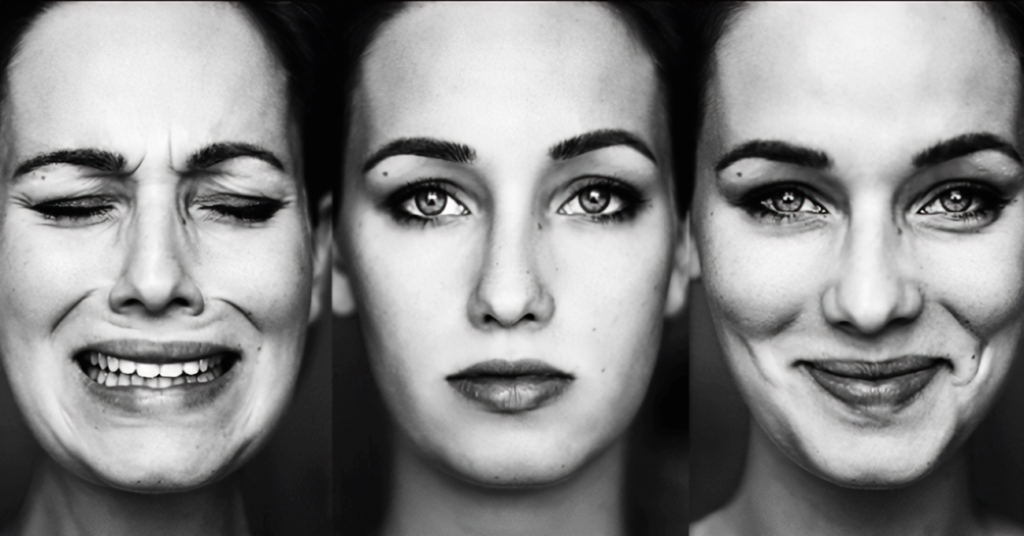

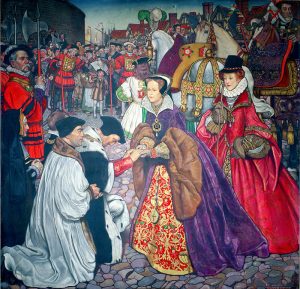

27 comments
Joseph Frausto
What an amazing and informative read! Is this problem being made worse by the advent of digital technology? Only time will tell, I reckon. Still, this article raises amazing points and certainly merits the discussion surrounding it. You have masterfully used words to represent complex ideas and manage to convey body language, a very visual medium, into language in a way that feels very well done. Congratulations.
Aaron Astudillo
Congratulations on the nomination! I think this article is very interesting as it over a topic that relates to facial expressions and gender. Furthermore, I have a more interesting take on this article as I am currently taking a gender politics class and what events can affect the outcomes of women in politics and society.
Karicia Gallegos
Congratulations on your nomination! This article sheds light on the effects of gender stereotypes on the perception of facial expressions. It highlights how societal norms impact how we interpret nonverbal cues, and how we often hold different standards for men and women. The article raises thought-provoking questions about the double standards that exist in our society and the importance of being aware of them. Overall, it is a fascinating read that encourages readers to reflect on their own biases. Great job!
Greitin Rodriguez
Communication, body language, and how one interprets is important and needed in order to have communication with one another. We all communicate differently and in different ways. We all have a different understanding. In order to understand and see the differences we need to be aware of how someone might interpret, understand, and react. We need to have communication and openness in order for things not to get out of control or misinterpret.
Maximillian Morise
Body Language is often a term used, but not understood. But I can tell from this article you not only understand what body language is, but did as much research as possible into the causes of it and how we respond to it, and how we adjust accordingly to it. Thank you for this well thought out article, and congratulations on your nomination!
Kristen Leary
This is a very interesting article topic, and is something I’ve always been curious about. I’ve heard it said that most of our communication as humans with other people is done nonverbally. Picking up on facial expression and body language is something we do without even thinking, and is something we constantly assess whether words are being said or not. Fascinating article, well done.
Gabriella Parra
Hannah! Congratulations on your nomination! It was interesting to think about how gender stereotypes applied by the perceiver and the perceived can effect the perception of a facial expression. What’s also interesting is the double-standard that we have when it comes to facial expressions. A nonverbal cue might seem normal when a man does it but aggressive when a woman does it. This article was super thought-provoking. Good job!
Alexia Gutierrez
How interesting that men and women generally use nonverbal cues differently! I have to say I never really noticed how men are less likely to use words like, “uh huh,” or “yeah” or head nodding to show that they are actively listening!
I enjoyed this article very much because now I know I will take the time to observe the differences in communication or nonverbal communication between genders! I feel like this has educated me in a way I would have never even researched on my own time! Wonderful article and now I will be hyperaware as I am definitely someone who actively nods in a classroom setting in addition to assuring whomever is speaking to me that I am actively listening by making direct eye contact or smiling.
Karah Renfroe
What a great article! This was very in-depth and throughly examined! A lot of us have heard about the role non-verbal cues have on communication, but may not know the degree or why it matters so much/ the effects it has. I liked that the article did not just do an overview on the topic, but rather focused on the distinction between the genders and their non-verbal cues. I believe this research could greatly improve relations and communications between men and women in fields where one sex clearly dominates. For example, in the field of law where men generally dominate by numbers, women and men alike would likely benefit from information like this in order to alleviate miscommunication concerns.
Barbara Ortiz
Congratulations on your nomination for such a great article. I found your topic quite interesting. I also wonder how data was affected during COVID when so much interaction was not “in person” and therefore the ability to read body when you might only be able to see a head, or if the camera was always off, then the traditional expressions you might catch are gone. Fascinating Topic!